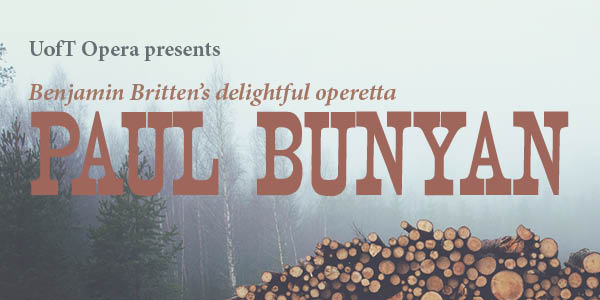U of T Opera presents an elaborate Paul Bunyan with Michael Patrick Albano (director) and Anna Theodosakis (choreographer) – review.

The University of Toronto Opera | Paul Bunyan, with Michael Patrick Albano (director) with Anna Theodosakis (choreographer); Thu Mar 10, at MacMillan Theatre.
Of the complete operatic oeuvre of English composer Benjamin Britten, his first opera, Paul Bunyan, is probably the most anachronistic and the most under-appreciated. Britten composed it when he was only 28, so it’s very much a young man’s work. With the imminent outbreak of WWII, Britten and his partner, tenor Peter Pears, were living in the U.S., and this “operetta” was his attempt at a certain down-home, folksy Americanism. The librettist was the great W H Auden, a personal friend of Britten’s.
It premiered in May 1941 at Columbia University. Given it’s the product of two Brits with sensibilities light years away from Yankee culture, the result was not unexpected. Despite a very accessible score containing elements of blues, jazz, folk mixed in with British Music Hall cum G&S, the result seems awfully self-conscious, more Kurt Weill than Broadway. It was not helped by a libretto with a surfeit of dry British humour in place of vaudeville belly laughs. Not well received by the public at the premiere, Britten withdrew the piece, only to revisit it in 1974, very late in his life, for a revival.
Perhaps part of the problem is that Paul Bunyan is not a frivolous story, at least not Britten’s vision of it. Rather it’s a work with a serious core. Labeling it an operetta is misleading. Based on the legend of the fictive Yankee lumberjack Paul Bunyan, the Britten creation is at heart a powerful social and political commentary on the American Dream, the struggle between typical wild west, rugged individualism on the one hand, and the need for tolerance of differences, of people from diverse cultures and traditions working together harmoniously for the sake of nation-building.
As I was sitting there in the audience taking it all in, the irony wasn’t lost on me. Here we are, in 2016, with all the shenanigans of the American primaries playing out in the news everyday, this piece takes on unexpected resonance. I had only seen it twice before, both in the 90’s, at Glimmerglass Opera and at the University of Toronto – I still recall Canadian tenor Michael Colvin as Johnny Inkslinger. It was amusing at the time but definitely not “deep.” I’m not going to re-tell the story here, but for anyone who’s curious enough to want to find out, I can recommend reading here.
Paul Bunyan is not a simple show to put on, given its huge ensemble cast and substantial scenery requirements – I counted some 60 people on stage at one time. The set by Fred Perruzza and costume by Lisa Magill were traditional and elaborate, one of the largest scaled productions I’ve seen at the opera school. The stage direction by Michael Patrick Albano was suitably middle of the road, going for humour rather than any attempt to underscore any hidden or not so hidden political commentaries.
The libretto by W H Auden has plenty of subtle humour, but most of it was lost on the audience – this isn’t intended as a put-down but a comment that wry British satire doesn’t go well with American slapstick. Let’s face it, parts of the story line are rather absurd – at the end of the opera, Tiny and Slim moving to New York to manage a hotel? Hel Helson goes to Washington DC to join the administration – oh really, Republican or Democrat? Also priceless is Inkslinger being called to Hollywood to work on a lumberjack movie! And all along, I thought the opening up of the American Frontier happened in the 19th century that predated Hollywood! Maybe it was the dry British humour at work again.
The huge ensemble cast was excellent all around. I particularly liked the well acted, slightly prissy bookkeeper Johnny Inkslinger of Daevyd Pepper, although the high tessitura gave his nice tenor quite a workout. The Narrator of Dan Mitton had just the right down-home, folksy feel. Soprano Danika Loren (Tiny) and tenor Conor Murphy (Hot Biscuit Slim) made a perfect pair of lovers, with Loren’s gleaming soprano a pleasure. The character roles of the swaggering lumberjacks (Daniel Robinson, Micah Schroeder, Matthew Cairns) and the bickering Swedes (Michael Johnston, Joey Jang, Joel Allison, Andrew Adridge) added the suitable colour to the proceedings. Cairns and Schroeder did double-duty as the two Bad Cooks, although their stuffed bulging bellies weren’t too convincing.
I also enjoyed the animals, particularly Caitlin McCaughey as Fido and the two cats (Victoria Marshall and Megan Quick). Paul Bunyan himself was heard but not seen, with the proper gravitas provided by the voice of Nicholas Borg. The orchestra played well under conductor Sandra Horst, although there were moments when a brisker and livelier tempo would have been to the good. The full chorus in the prologue with the Old Trees, Young Trees and the Wild Geese had some tentative moments in the beginning, but it all ended well. Perhaps not the piece that would go into the annals as a desert island show, but for a university music department to put on such an elaborate and enjoyable presentation, it deserved the highest praise.
Follow Musical Toronto on Facebook for the latest classical and opera news, pretty pics, funny stuff, and an insider POV.
- SCRUTINY | Opera Atelier’s All Is Love Makes Triumphal Return - April 15, 2024
- SCRUTINY | From The Heart: Ema Nikolovska And Charles Richard-Hamelin Offer Unique Program At Koerner Hall - March 26, 2024
- SCRUTINY | The Glenn Gould School Spring Opera Presents A Superb Dialogues Des Carmélites - March 22, 2024



